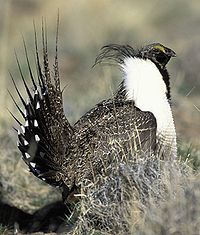
War Horse National Wildlife Refuge
Encyclopedia
War Horse National Wildlife Refuge, located in the center of the U.S. state
of Montana
, is divided into three separate sections, with each centered around a small body of water. It is an integral part of the Charles M. Russell National Wildlife Refuge Complex
, although the refuge is normally unstaffed and has few visitor improvements. One reservoir is stocked with trout
, although its two lakes are sometimes empty. When the lakes and reservoir are fully filled, the refuge provides excellent habitat for migratory bird species. The region is surrounded by sagebrush
When the lakes and reservoir are fully filled, the refuge provides excellent habitat for migratory bird species. The region is surrounded by sagebrush
plains and unusual Ponderosa pine
groves that flourish in the region solely due to its acid-shale soils. Along with over 100 bird species, regular inhabitants include Sage grouse
, Pronghorn
and Mule deer
.
U.S. state
A U.S. state is any one of the 50 federated states of the United States of America that share sovereignty with the federal government. Because of this shared sovereignty, an American is a citizen both of the federal entity and of his or her state of domicile. Four states use the official title of...
of Montana
Montana
Montana is a state in the Western United States. The western third of Montana contains numerous mountain ranges. Smaller, "island ranges" are found in the central third of the state, for a total of 77 named ranges of the Rocky Mountains. This geographical fact is reflected in the state's name,...
, is divided into three separate sections, with each centered around a small body of water. It is an integral part of the Charles M. Russell National Wildlife Refuge Complex
Charles M. Russell National Wildlife Refuge Complex
Charles M. Russell National Wildlife Refuge Complex consists of six National Wildlife Refuges, all of them managed by the U.S. Fish and Wildlife Service. The refuges are located in the central sections of the U.S. state of Montana. The complex includes the following areas:*Charles M...
, although the refuge is normally unstaffed and has few visitor improvements. One reservoir is stocked with trout
Trout
Trout is the name for a number of species of freshwater and saltwater fish belonging to the Salmoninae subfamily of the family Salmonidae. Salmon belong to the same family as trout. Most salmon species spend almost all their lives in salt water...
, although its two lakes are sometimes empty.

Sagebrush
Sagebrush is a common name of a number of shrubby plant species in the genus Artemisia native to western North America;Or, the sagebrush steppe ecoregion, having one or more kinds of sagebrush, bunchgrasses and others;...
plains and unusual Ponderosa pine
Ponderosa Pine
Pinus ponderosa, commonly known as the Ponderosa Pine, Bull Pine, Blackjack Pine, or Western Yellow Pine, is a widespread and variable pine native to western North America. It was first described by David Douglas in 1826, from eastern Washington near present-day Spokane...
groves that flourish in the region solely due to its acid-shale soils. Along with over 100 bird species, regular inhabitants include Sage grouse
Sage Grouse
The Sage Grouse is the largest grouse in North America, where it is known as the Greater Sage-Grouse. Its range is sagebrush country in the western United States and southern Alberta and Saskatchewan, Canada. A population of smaller birds, known in the U.S. as Gunnison Sage-Grouse, were recently...
, Pronghorn
Pronghorn
The pronghorn is a species of artiodactyl mammal endemic to interior western and central North America. Though not an antelope, it is often known colloquially in North America as the prong buck, pronghorn antelope, or simply antelope, as it closely resembles the true antelopes of the Old World and...
and Mule deer
Mule Deer
The mule deer is a deer indigenous to western North America. The Mule Deer gets its name from its large mule-like ears. There are believed to be several subspecies, including the black-tailed deer...
.

